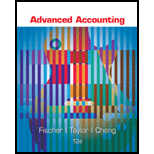
Advanced Accounting
12th Edition
ISBN: 9781305084858
Author: Paul M. Fischer, William J. Tayler, Rita H. Cheng
Publisher: Cengage Learning
expand_more
expand_more
format_list_bulleted
Concept explainers
Question
Chapter 3, Problem 3.3.1P
To determine
Determination and distribution of excess income schedule
Through this price paid for subsidiary equity is compared with predetermine imbalance which is occurred in the consolidated worksheet because of elimination of in the investment account against the underlying subsidiary equity.
To calculate:
Prepare determination and distribution of excess income schedule for the year end December 31, 2016.
Expert Solution & Answer
Want to see the full answer?
Check out a sample textbook solution
Students have asked these similar questions
help this correct option
General Accounting
Please solve this question General accounting and step by step explanation
Chapter 3 Solutions
Advanced Accounting
Ch. 3 - Prob. 1UTICh. 3 - Prob. 2UTICh. 3 - Prob. 3UTICh. 3 - Prob. 4UTICh. 3 - Prob. 5UTICh. 3 - Prob. 6UTICh. 3 - Prob. 7UTICh. 3 - Prob. 1ECh. 3 - Prob. 2ECh. 3 - Prob. 3.1E
Ch. 3 - Prob. 3.2ECh. 3 - Prob. 3.3ECh. 3 - Prob. 3.4ECh. 3 - Prob. 3.5ECh. 3 - Equity method, second year, eliminations, income...Ch. 3 - Prob. 4.2ECh. 3 - Prob. 5.1ECh. 3 - Prob. 5.2ECh. 3 - Prob. 5.3ECh. 3 - Prob. 5.4ECh. 3 - Prob. 5.5ECh. 3 - Prob. 6.1ECh. 3 - Prob. 6.2ECh. 3 - Prob. 7.1ECh. 3 - Prob. 7.2ECh. 3 - Prob. 7.3ECh. 3 - Prob. 7.4ECh. 3 - Prob. 7.5ECh. 3 - Prob. 8.1ECh. 3 - Prob. 8.2ECh. 3 - Prob. 9ECh. 3 - Prob. 10.1ECh. 3 - Prob. 10.2ECh. 3 - Prob. 10.3ECh. 3 - Prob. 11ECh. 3 - Prob. 3B.1.1AECh. 3 - Prob. 3B.1.2AECh. 3 - Prob. 3B.1.3AECh. 3 - Prob. 3B.2.1AECh. 3 - Prob. 3B.2.2AECh. 3 - Prob. 3B.3AECh. 3 - Prob. 3.1.1PCh. 3 - Prob. 3.1.2PCh. 3 - Prob. 3.1.3PCh. 3 - Prob. 3.2.1PCh. 3 - Prob. 3.2.2PCh. 3 - Prob. 3.3.1PCh. 3 - Prob. 3.3.2PCh. 3 - Prob. 3.3.3PCh. 3 - Prob. 3.3.4PCh. 3 - Prob. 3.4.1PCh. 3 - Prob. 3.4.2PCh. 3 - Prob. 3.5.1PCh. 3 - Prob. 3.5.2PCh. 3 - Prob. 3.5.3PCh. 3 - Prob. 3.6.1PCh. 3 - Prob. 3.6.2PCh. 3 - Prob. 3.6.3PCh. 3 - Prob. 3.7.1PCh. 3 - Prob. 3.7.2PCh. 3 - Prob. 3.7.3PCh. 3 - Prob. 3.8.1PCh. 3 - Prob. 3.8.2PCh. 3 - Prob. 3.9.1PCh. 3 - Prob. 3.9.2PCh. 3 - Prob. 3.10.1PCh. 3 - Prob. 3.10.2PCh. 3 - Prob. 3.11.1PCh. 3 - Prob. 3.11.2PCh. 3 - Prob. 3.12.1PCh. 3 - Prob. 3.12.2PCh. 3 - Prob. 3.13.1PCh. 3 - Prob. 3.13.2PCh. 3 - Prob. 3.15.1PCh. 3 - Prob. 3.15.2PCh. 3 - Prob. 3.16.1PCh. 3 - Prob. 3.16.2PCh. 3 - Prob. 3.17.1PCh. 3 - Prob. 3.17.2PCh. 3 - Prob. 3.18.1PCh. 3 - Prob. 3.18.2PCh. 3 - Prob. 3A.1.1APCh. 3 - Prob. 3A.1.2APCh. 3 - Prob. 3A.2APCh. 3 - Prob. 3A.3APCh. 3 - Prob. 3B.1APCh. 3 - Prob. 3B.2APCh. 3 - Prob. 3B.3.1APCh. 3 - The trial balances of Campton Corporation and Dorn...Ch. 3 - The trial balances of Campton Corporation and Dorn...
Knowledge Booster
Learn more about
Need a deep-dive on the concept behind this application? Look no further. Learn more about this topic, accounting and related others by exploring similar questions and additional content below.Similar questions
arrow_back_ios
SEE MORE QUESTIONS
arrow_forward_ios
Recommended textbooks for you
 Financial AccountingAccountingISBN:9781305088436Author:Carl Warren, Jim Reeve, Jonathan DuchacPublisher:Cengage Learning
Financial AccountingAccountingISBN:9781305088436Author:Carl Warren, Jim Reeve, Jonathan DuchacPublisher:Cengage Learning

Financial Accounting
Accounting
ISBN:9781305088436
Author:Carl Warren, Jim Reeve, Jonathan Duchac
Publisher:Cengage Learning